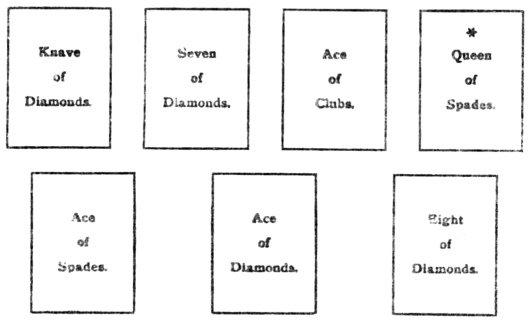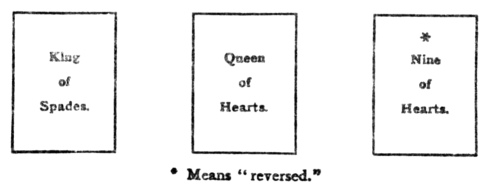Fortune Telling by Cards, by P.R.S. Foli, [1915], at sacred-texts.com
CHAPTER VI
Your Fortune in Twenty-one Cards
A reduced pack—An example—The three packs—The surprise.
THIS method requires a pack of thirty-two cards, although only twenty-one of them are actually used in the process. The whole pack must be well shuffled and cut with the left hand. The dealer then takes off the first eleven cards and throws them aside. From the twenty-one left in his hand he takes the uppermost card and places it apart for "the surprise" before dealing out the other twenty and placing them in order on the table before him. If the card representing the inquirer is not among them the whole process must be repeated from the beginning.
The signification of the cards must be read, taking care to notice any set of two, three, or four of a kind, as their collective meaning should be added to the individual explanation. After this has been done the twenty cards should be taken in order, starting from the left, and their meanings linked up together as a continuous message.
The cards must now be taken up again, shuffled, and cut as before. The dealer then makes them into three packs, having been careful to place the first card apart for "the surprise." Two of the packs will consist of seven cards, the third of only six. The inquirer is then asked to choose one of the packs, which must be exposed face upwards, moving from left to right, and these six or seven cards, as the case may be, should be read according to their significations. This operation is repeated three times, so that at the finish "the surprise" consists of three cards, which Are exposed and read last of all.
An Example.
The accompanying example will make the foregoing explanation more lucid and interesting.
We will take the knave of clubs as the representative of the inquirer, a dark, clever, well-intentioned young man. The twenty-one cards come out in the following order, beginning from the left:—
Queen of hearts, reversed.
Ace of hearts.
Knave of clubs.
Ace of spades, reversed.
Ace of clubs.
Knave of hearts.
King of hearts.
Queen of spades, reversed.
Nine of hearts.
Knave of diamonds.
Ten of spades.
Ace of diamonds, reversed.
King of diamonds.
Seven of diamonds.
Eight of diamonds.
Eight of spades, reversed.
Seven of clubs, reversed.
Nine of clubs, reversed.
Nine of diamonds.
The surprise, placed apart.
Before taking the individual significance of each card we will look at some of the combinations. There are the four aces, telling of bad news, relating to trouble through the affections, but two being reversed mitigate the evil, and give a ray of hope to the inquirer. The three kings tell of an important undertaking which will be discussed and carried through successfully by the young man, who has excellent abilities. The two queens, both reversed, warn the inquirer that he will suffer from the result of his own actions, more especially as the queen of spades in an inverted position represents a
malicious and designing widow. It will be found as the process develops that she is very much to the fore with regard to the inquirer's affairs. The three knaves confirm the foregoing reading, for they betoken annoyances and worries from acquaintances, ending even in slander. The three nines, one of them reversed, speak of happiness and entire success in an undertaking, though the inversion shows that there will be a slight, passing difficulty to overcome. The two eights refer to flirtations on the part of the inquirer, and one being reversed warns him that he will have to pay for some of his fun. The two sevens tell of mutual love between the young man and the lady of his choice, but as the one is reversed there will be deceit at work to try and separate them.
Now let us see what the twenty cards have to say taken consecutively. We start off with the king of spades, a clever, ambitious, but unscrupulous man who has been instrumental in thwarting the love affairs of the fair, lovable, and tender-hearted woman, the queen of hearts, upon whom the inquirer has set his affections. The ace of hearts following her is the love letter she will receive from the inquirer, the knave of clubs; but he is next to the ace of spades, reversed, foretelling grief to him, which may affect his health, and the ace of clubs coming immediately after points to the cause being connected with money. The next three cards are court cards, and that means gaiety, in which the inquirer will be mixed up with a lively young bachelor—the knave of hearts—a fair, generous, but hot-tempered man—the king of diamonds—and the malicious, spiteful widow represented by the queen of spades, reversed. The inquirer will meet with pleasure, caused by success, the nine of hearts; but this is closely followed by the knave of diamonds, an unfaithful friend, who will try to bring disgrace, the ten of spades, upon his betters, and will write a letter containing unpleasant news—the ace of diamonds, reversed—which will concern or be prompted by the king of diamonds, a military man who has a grievance with regard to his love affairs and who is not above having recourse to scandal, the seven of diamonds, to avenge his wounded vanity. The next card is the eight of diamonds, the sign of some love-making, but our young people are not at the end of their troubles yet, for the eight of spades, reversed, tells us that his offer of marriage will be rejected. The seven of clubs is
a card of caution, and implies danger from the opposite sea, so we gather that the spiteful widow has been at work, and is possibly to blame for his rejection; this idea is further strengthened by the nine of clubs, also reversed, coming immediately, which suggests letters that may have done the mischief. The nine of diamonds tells of the annoyance caused by these events, and their effect upon the affections of a dark person, the inquirer, who is a man well worth having.
The Three Packs.
In the first deal the inquirer chooses the middle pack, which contains the following cards: the knave of diamonds, the seven of diamonds, the ace of clubs, the queen of spades, reversed, the ace of spades, the ace of diamonds, the eight of diamonds.
We notice that three aces come out in this pack and show passing troubles in love affairs. The knave of diamonds, an unfaithful friend, is mixed up in scandal, the seven of diamonds, conveyed in a letter, the ace of clubs, written or instigated by the spiteful widow, the queen of spades. The ace of spades betokens sickness, but it is followed by the ace of diamonds, the wedding ring, and the pack closes with the eight of diamonds, telling of a happy marriage for the inquirer after all his worries.
In the second deal he again selects the middle pack, and we see the following: the queen of spades, reversed as usual, the nine of clubs, reversed, the seven of clubs, reversed, the nine of hearts, the seven of diamonds, the eight of clubs.
There are two nines, one reversed, speaking of small worries, and two sevens, one reversed, which show there is deceit at work. The pack reads thus: the queen of spades, the spiteful widow, who seems to be ubiquitous, is followed by the nine of clubs, representing the letter referred to above, and the seven of clubs standing next to it sounds a word of caution to the inquirer as to his lady friend, so-called; be will probably succeed in outwitting the widow, for the next card is the nine of hearts, implying joy and success in spite of scandal, the seven of diamonds with reference to his affections represented by the eight of clubs.
In the third deal the inquirer still is faithful to the middle
The Three Packs
What the first selected pack contains—
The three cards forming the Surprise—
pack, and we find the following cards: the ace of diamonds, ten of spades, reversed, queen of spades, reversed, nine of diamonds, reversed, seven of clubs, reversed, ace of clubs, reversed.
The two aces, one of them reversed, tell of a union between two parties, but as the colours cross and one is reversed the result will not be known at. present. Here we get the wedding-ring, the ace of diamonds, followed by the ten of spades, reversed, which speaks of brief sorrow, occasioned doubtless by the spiteful widow, who again appears reversed, and intent upon mischief; next to her comes the nine of diamonds, reversed, signifying a love quarrel; the seven of clubs, reversed, gives a word of caution to the inquirer with regard to the opposite sex; the last card is the ace of clubs, reversed, which means joy soon followed by sorrow.
It is remarkable that the queen of spades comes out in each of the packs and is reversed every time.
The Surprise.
The surprise is now turned up and contains the king of spades, a dark, ambitious unscrupulous man who has interfered with the love affairs of the fair woman, the queen of hearts, to whom the inquirer has made an offer, so far without success; the third card is the nine of hearts, reversed, which tells that it will be but a passing cloud that will separate the lovers.



